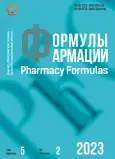Antimicrobial activity of probiotic strain Enterococcus faecium 1-35
- 作者: Brazhnik E.A.1,2, Bikonia S.N.1,2, Laptev G.Y.2,3
-
隶属关系:
- Volgograd State Agrarian University
- BIOTROPH Ltd
- Saint Petersburg State Agrarian University
- 期: 卷 5, 编号 2 (2023)
- 页面: 60-64
- 栏目: Actual problems: discussion tribune
- URL: https://journal-vniispk.ru/PharmForm/article/view/249542
- DOI: https://doi.org/10.17816/phf352543
- ID: 249542
如何引用文章
全文:
详细
The study examines the search for alternative solutions to replace feed antibiotics for poultry farming. During the study of the probiotic strain Enterococcus faecium 1-35, its antimicrobial properties against some pathogenic microorganisms were established. Using a bioinformatics approach, genes for non-ribosomal peptide synthetases were discovered in the genome of Enterococcus faecium 1-35. A synthesis product of which is believed to have biological activity. Enterococcus faecium strain 1-35, capable of synthesizing active peptide products, can be regarded as an alternative solution when replacing feed antibiotics. The results obtained require additional studies of practical application to confirm the expected effect.
作者简介
Evgenii Brazhnik
Volgograd State Agrarian University; BIOTROPH Ltd
编辑信件的主要联系方式.
Email: bea@biotrof.ru
SPIN 代码: 3776-1982
graduate student of the department “Feeding and breeding of agricultural animals, quality controller of BIOTROPH Ltd
俄罗斯联邦, Volgograd; Saint Petersburg, PushkinSvetlana Bikonia
Volgograd State Agrarian University; BIOTROPH Ltd
Email: svetlana@biotrof.ru
SPIN 代码: 9451-8405
graduate student of the department “Feeding and breeding of agricultural animals”, deputy chief technologist of BIOTROPH Ltd
俄罗斯联邦, Volgograd; Saint Petersburg, PushkinGeorgii Laptev
BIOTROPH Ltd; Saint Petersburg State Agrarian University
Email: laptev@biotrof.ru
SPIN 代码: 3600-5295
Doctor of Biological Science, head of department “Biotechnology of feed”, Director of BIOTROPH Ltd
俄罗斯联邦, Saint Petersburg, Pushkin; Saint Petersburg, Pushkin参考
- Fischbach M. A, Walsh C. T. Antibiotics for emerging pathogens. Science (New York, N.Y.). 2009 Aug;325(5944):1089–1093. doi: 10.1126/science.1176667.
- Okolelova T. M., Egorova T. V. and others. Guidelines for the use of biological products and feed additives to ensure the health and increase the productivity of broilers. Methodological recommendations // Sergiev Posad. 2013. (In Russ).
- Prjibelski A., Antipov D., Meleshko D., Lapidus A., & Korobeynikov A. (2020). Using SPAdes de novo assembler. Current Protocols in Bioinformatics, 70, e102. doi: 10.1002/cpbi.102.
- Blin K. [et al.]. antiSMASH 5.0: updates to the secondary metabolite genome mining pipeline // Nucleic Acids Res. – 2019. – Vol. 47, № W1. – P. W81–W87. doi: 10.1093/nar/gkz310.
- Flissi A, Dufresne Y, Michalik J, Tonon L, Janot S, Noé L, Jacques P, Leclère V, Pupin M. Norine, the knowledgebase dedicated to non-ribosomal peptides, is now open to crowdsourcing. Nucleic Acids Res. 2016 Jan 4;44(D1):D1113–8. doi: 10.1093/nar/gkv1143.
- Orlova T. I., Bulgakova V. G., Polin A. N. Biologically active non-ribosomal peptides. III. The mechanism of biosynthesis of non-ribosomal peptides // Antibiotics and chemotherapy. 2012, no. 7–8 (57). pp. 43–54. (In Russ).
- Kirstein J, Hoffmann A, Lilie H, Schmidt R, Rübsamen-Waigmann H, Brötz-Oesterhelt H, Mogk A, Turgay K. The antibiotic ADEP reprogrammes ClpP, switching it from a regulated to an uncontrolled protease. EMBO Mol Med. 2009 Apr;1(1):37–49. doi: 10.1002/emmm.200900002.
补充文件







